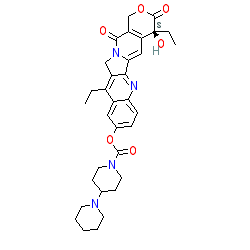|
Synonyms: (+)-irinotecan | biotecan | Campto® | Camptosar® | CPT-11 | irinotecan hydrochloride | Onivyde®
irinotecan is an approved drug (FDA (1996), EMA (2016))
Compound class:
Synthetic organic
Comment: Irinotecan is a semisynthetic analogue of the natural plant alkaloid camptothecin (PubChem CID 24360) which functions as a DNA replication inhibitor by binding to topoisomerase I/DNA complexes [5]. Camptothecin was first isolated from the bark and stem of Camptotheca acuminata, the Chinsese happy tree.
The PubChem CID linked here is the same isomer as recorded in irinotecan's INN record. Ligand Activity Visualisation ChartsThese are box plot that provide a unique visualisation, summarising all the activity data for a ligand taken from ChEMBL and GtoPdb across multiple targets and species. Click on a plot to see the median, interquartile range, low and high data points. A value of zero indicates that no data are available. A separate chart is created for each target, and where possible the algorithm tries to merge ChEMBL and GtoPdb targets by matching them on name and UniProt accession, for each available species. However, please note that inconsistency in naming of targets may lead to data for the same target being reported across multiple charts. ✖
View more information in the IUPHAR Pharmacology Education Project: irinotecan |
|
|||||||||||||||||||||||||||||||||||
| References |
|
1. Chrencik JE, Staker BL, Burgin AB, Pourquier P, Pommier Y, Stewart L, Redinbo MR. (2004)
Mechanisms of camptothecin resistance by human topoisomerase I mutations. J Mol Biol, 339 (4): 773-84. [PMID:15165849] |
|
2. Dodds HM, Haaz MC, Riou JF, Robert J, Rivory LP. (1998)
Identification of a new metabolite of CPT-11 (irinotecan): pharmacological properties and activation to SN-38. J Pharmacol Exp Ther, 286 (1): 578-83. [PMID:9655905] |
|
3. Kunimoto T, Nitta K, Tanaka T, Uehara N, Baba H, Takeuchi M, Yokokura T, Sawada S, Miyasaka T, Mutai M. (1987)
Antitumor activity of 7-ethyl-10-[4-(1-piperidino)-1-piperidino]carbonyloxy-camptothec in, a novel water-soluble derivative of camptothecin, against murine tumors. Cancer Res, 47 (22): 5944-7. [PMID:3664496] |
|
4. Matsuzaki T, Yokokura T, Mutai M, Tsuruo T. (1988)
Inhibition of spontaneous and experimental metastasis by a new derivative of camptothecin, CPT-11, in mice. Cancer Chemother Pharmacol, 21 (4): 308-12. [PMID:3370738] |
|
5. Pommier Y, Redon C, Rao VA, Seiler JA, Sordet O, Takemura H, Antony S, Meng L, Liao Z, Kohlhagen G et al.. (2003)
Repair of and checkpoint response to topoisomerase I-mediated DNA damage. Mutat Res, 532 (1-2): 173-203. [PMID:14643436] |
|
6. Staker BL, Hjerrild K, Feese MD, Behnke CA, Burgin Jr AB, Stewart L. (2002)
The mechanism of topoisomerase I poisoning by a camptothecin analog. Proc Natl Acad Sci USA, 99 (24): 15387-92. [PMID:12426403] |
|
7. Tanizawa A, Fujimori A, Fujimori Y, Pommier Y. (1994)
Comparison of topoisomerase I inhibition, DNA damage, and cytotoxicity of camptothecin derivatives presently in clinical trials. J Natl Cancer Inst, 86 (11): 836-42. [PMID:8182764] |
|
8. Tsuruo T, Matsuzaki T, Matsushita M, Saito H, Yokokura T. (1988)
Antitumor effect of CPT-11, a new derivative of camptothecin, against pleiotropic drug-resistant tumors in vitro and in vivo. Cancer Chemother Pharmacol, 21 (1): 71-4. [PMID:3342468] |








